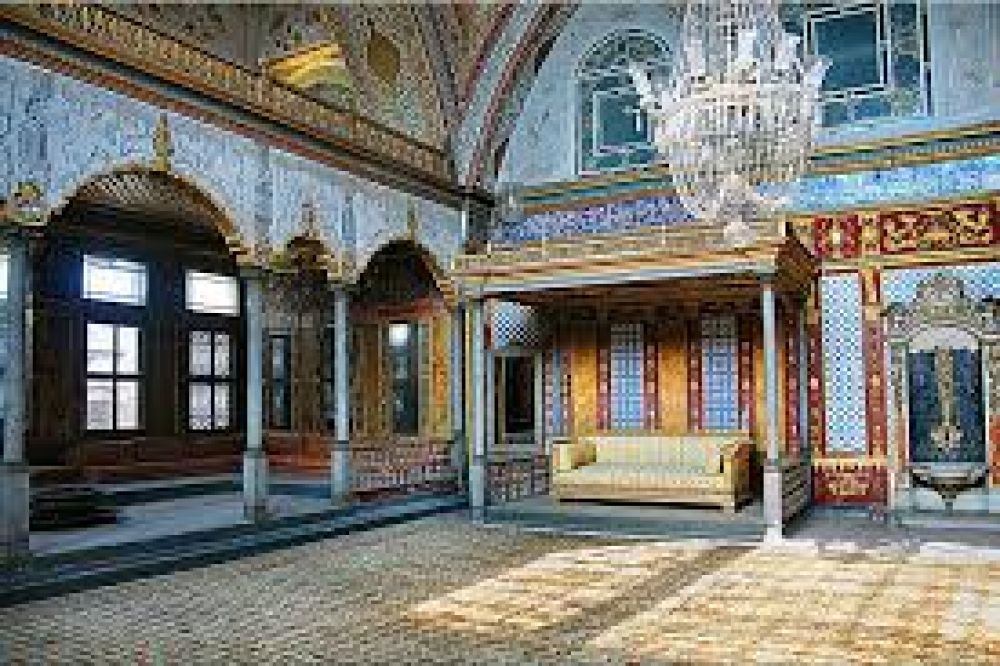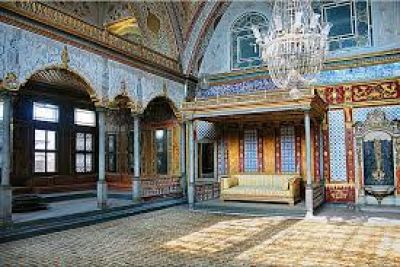

Explore the mysterious world of the sultans, their concubines, and eunuchs with a guided tour of the Harem Section in Topkapi Palace. This private living space of the Ottoman sultans is adorned with beautiful tiles and woodwork, showcasing the opulent lifestyle and intricate hierarchy that defined Ottoman court culture. Visitors will be taken through various rooms, including the Courtyard of the Eunuchs, the Imperial Hall, and the Queen Mother's quarters. The Harem is a testament to the palace's architectural grandeur and offers insights into the private lives of the sultans. As you walk through the corridors and chambers, you will hear captivating stories and secrets that paint a vivid picture of life in the Ottoman era.
The Imperial Treasury in Topkaki Palace is a magnificent exhibit showcasing the opulent wealth of the Ottoman Empire. This guided tour will lead you through a stunning collection of precious gems, gold artifacts, and artistry of incredible historical significance. Highlights include the Spoonmaker's Diamond, considered the fourth largest diamond of its kind in the world, and the Topkapi Dagger, encrusted with jewels. The treasury holds myriad other treasures from the Ottoman period, ranging from ceremonial robes to intricate jewel boxes. Visitors will gain an appreciation of the craftsmanship and aesthetic richness of the time while learning about the intriguing backstories of these treasures, which have been preserved for centuries.
The Sultan Ahmet Tour takes visitors on a journey through some of the most significant historical monuments in Istanbul, located within walking distance from Topkapi Palace. The tour includes visits to the Sultan Ahmet Mosque (also known as the Blue Mosque), the ancient Hippodrome, and the awe-inspiring Hagia Sophia. With more than 1500 years of history, Hagia Sophia, in particular, stands as a testament to the city's diverse past, having served as both a cathedral and a mosque. The Blue Mosque, famous for its interior lined with blue ?znik tiles, is an active place of worship as well as a popular tourist site. Tour guides will provide historical context and stories about the Ottoman Empire and the Byzantine period, making this a rich cultural and educational experience.
This particular tour will lead visitors through the opulent ceremonial rooms of the Topkapi Palace, where sultans once entertained foreign dignitaries and held grand state events. Admire the elaborate ceilings, sumptuous furnishings, and ornate decorations that define Ottoman luxury. The tour continues to exhibit the Holy Relics, which include sacred items cherished by the Muslim world, such as Prophet Muhammad's cloak and sword. The relics have been meticulously preserved and displayed, providing a unique opportunity for both Islamic followers and history enthusiasts to witness artifacts of significant religious heritage. Guides will share accounts of the relics' histories and their importance to the palace and the empire.
The tour of the Topkapi Palace kitchens and the Porcelain Collection takes visitors back in time to the days when meals for thousands were prepared daily. As one of the largest kitchens of its time, the Ottoman culinary culture thrived here, influenced by the many regions under the empire's control. The tour illustrates the grand scale of palace life and includes viewing a vast array Venice, Japanese, Chinese and ?znik porcelain, which were used for banquets and royal gatherings. You'll be captivated by the array of culinary equipment and utensils on display, some of which are unique archaeological finds, as well as the stories of palace cooks and their prestigious yet demanding role in ensuring the sultans and their courts were well-fed.
As you walk through the grand Gate of Salutation, you enter the Second Courtyard of Topkapi Palace, where you can explore the Divan or Imperial Council chamber. The tour takes visitors to the heart of the palace's administrative center, explaining how the Ottoman government operated, the imperial decision-making process, and the roles of the viziers and other officials. The Divan is also where ambassadors were received and where major state affairs were discussed. The beautifully decorated chamber and its surroundings are a showcase of the power and intrigue that characterized the political life of the empire. Learn about the secretive meetings, imperial edicts, and political machinations that took place within these walls from knowledgeable guides.
Venture to the Fourth Courtyard of Topkapi Palace for a leisurely stroll through the palace's most serene gardens. The tour reveals the private pleasure grounds once exclusively enjoyed by the sultan and his entourage. This area includes several terraces with beautiful pavilions like the Iftar Pavilion, overlooking the Golden Horn, and the Baghdad Pavilion, commemorating Sultan Murad IV's victory in Baghdad. The extensive landscape showcases an array of historic marble fountains, ornate terraces, and a variety of flora that create a tranquil atmosphere within the palace. Visitors can take a moment to enjoy the breathtaking views of the Bosphorus and the Asian side of Istanbul from the palace's elevated vantage points.
For those interested in fashion and textiles, the Royal Costume Exhibit at Topkapi Palace offers a glimpse into the sumptuous attire of the Ottoman sultans and their courts. Located in some of the palace rooms, the exhibit displays a rich array of clothing, including ceremonial robes, kaftans, accessories, and jewel-encrusted garments. Each piece is a work of art, reflecting the luxury, tradition, and craftsmanship of the Ottoman Empire. The exhibit explains the symbolism behind different garments, colors, and patterns, as well as their significance in court hierarchy and ceremonies. History buffs and fashion enthusiasts alike will be fascinated by the variety and splendor of the historical costumes on display.
The Imperial Armory Exhibition in Topkapi Palace showcases an impressive collection of Ottoman weaponry, armor, and martial equipment. Spanning centuries of craftsmanship and innovation, the armory contains items such as swords, bows, arrows, shields, and guns used by the Ottoman army and the sultans themselves. Many pieces are ornately decorated and inlaid with precious metals and stones, illustrating the empire's wealth and the high status of warfare in Ottoman society. Throughout the exhibition, visitors will learn about the evolution of Ottoman military technology, the personal weapons of famous sultans, and the art of war in the context of both defense and ceremonial representation.
The Sacred Safekeeping Rooms, or 'Chambers of the Sacred Relics' within Topkapi Palace, are among the most spiritually significant sections of the palace. They house relics of Prophet Muhammad and other prophets that are revered in Islam. Among these are the Prophet's mantle, his footprint, a strand of his beard, the staff of Moses, the sword of David, and many other items of profound religious importance. The rooms themselves are beautifully decorated with Ottoman calligraphy and craftsmanship, creating an amboreal setting for these cherished artifacts. Throughout the tour, visitors will be given insights into the history and religious significance of each relic, enhancing the experience with a deeper understanding of Islamic heritage.
